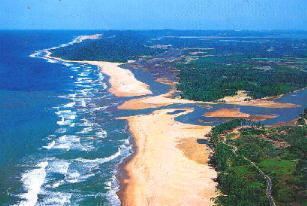 | ||
In the deep ocean, marine snow is a continuous shower of mostly organic detritus falling from the upper layers of the water column. It is a significant means of exporting energy from the light-rich photic zone to the aphotic zone below. The term was first coined by the explorer William Beebe as he observed it from his bathysphere. As the origin of marine snow lies in activities within the productive photic zone, the prevalence of marine snow changes with seasonal fluctuations in photosynthetic activity and ocean currents. Marine snow can be an important food source for organisms living in the aphotic zone, particularly for organisms which live very deep in the water column.
Contents
Composition
Marine snow is made up of a variety of mostly organic matter, including dead or dying animals and phytoplankton, protists, fecal matter, sand, and other inorganic dust. Most trapped particles are more vulnerable to grazers than they would be as free floating individuals and can be classified as "olive green" or "gray body" cells, which are plant parts and degrading plant material. A majority of marine snow composition is actually made up of aggregates of smaller particles held together by a sugary mucus, transparent extracellular polysaccharides (TEPs). These are natural polymers exuded as waste products mostly by phytoplankton and bacteria. Mucus secreted by zooplankton (mostly salps, appendicularians, and pteropods) also contribute to the constituents of marine snow aggregates. These aggregates grow over time and may reach several centimeters in diameter, traveling for weeks before reaching the ocean floor.
Marine snow often forms during algal blooms. As phytoplankton accumulate, they aggregate or get captured in other aggregates, both of which accelerate the sinking rate. Aggregation and sinking is actually thought to be a large component of sources for algae loss from surface water. Most organic components of marine snow are consumed by microbes, zooplankton and other filter-feeding animals within the first 1,000 metres of their journey. In this way marine snow may be considered the foundation of deep-sea mesopelagic and benthic ecosystems: As sunlight cannot reach them, deep-sea organisms rely heavily on marine snow as an energy source. The small percentage of material not consumed in shallower waters becomes incorporated into the muddy "ooze" blanketing the ocean floor, where it is further decomposed through biological activity.
Marine snow aggregates exhibit characteristics that fit Goldman's "aggregate spinning wheel hypothesis". This hypothesis states that phytoplankton, microorganisms and bacteria live attached to aggregate surfaces and are involved in rapid nutrient recycling. Phytoplankton have been shown to be able to take up nutrients from small local concentrations of organic material (e.g. fecal matter from an individual zooplankton cell, regenerated nutrients from organic decomposition by bacteria). As the aggregates slowly sink to the bottom of the ocean, the many microorganisms residing on them are constantly respiring and contribute greatly to the microbial loop.
Aggregation
Aggregates begin as the colloidal fraction, which typically contains particles sized between 1 nm and several micrometers. The colloidal fraction of the ocean contains a large amount of organic matter unavailable to grazers. This fraction has a much higher total mass than either phytoplankton or bacteria but is not readily available due to size characteristics of the particles in relation to potential consumers. The colloidal fraction must aggregate in order to be more bioavailable. Aggregation theory outlines main mechanisms by which marine aggregates may form and are as follows:
Brownian motionShearDifferential SettlingDiffusive CaptureSurface CoagulationFiltrationBacterial MotilityAggregation theory represents a two state system. At low cell concentrations aggregation is relatively unimportant and somewhat more unlikely. However, at higher cell concentrations it becomes increasingly important. A model has been proposed to characterize the formation of marine aggregates and the loss due to sinking:
Thus, aggregation of marine particles is more prevalent when cell and particle concentration is higher (e.g. algal blooms)
Study
Export production is the amount of organic matter produced in the ocean by primary production that is not recycled (remineralised) before it sinks into the aphotic zone. Because of the role of export production in the ocean's biological pump, it is typically measured in units of carbon (e.g. mg C m−2 d−1).
The fraction of primary production that is exported to the aphotic zone is generally higher when primary production occurs in short (seasonal) bursts, than when it occurs more evenly spread out across a year.
Because of the relatively long residence time of the ocean's thermohaline circulation, carbon transported as marine snow into the deep ocean by the biological pump can remain out of contact with the atmosphere for more than 1000 years. That is, when the marine snow is finally decomposed to inorganic nutrients and dissolved carbon dioxide, these are effectively isolated from the surface ocean for relatively long time-scales related to ocean circulation. Consequently, enhancing the quantity of marine snow that reaches the deep ocean is the basis of several geoengineering schemes to enhance carbon sequestration by the ocean. Ocean nourishment and iron fertilisation seek to boost the production of organic material in the surface ocean, with a concomitant rise in marine snow reaching the deep ocean. These efforts have not yet produced a sustainable fertilization that effectively transports carbon out of the system.
Increases in ocean temperatures, a projected indicator of climate change, may result in a decrease in the production of marine snow due to the enhanced stratification of the water column. Increasing stratification decreases the availability of phytoplankton nutrients such as nitrate, phosphate and silicic acid, and could lead to a decrease in primary production and, thus, marine snow.
Marine snow has also begun to garner interest from microbiologists, owing to the microbial communities associated with it. Recent research indicates transported bacteria may exchange genes with previously thought to be isolated populations of bacteria inhabiting the breadth of the ocean floor. In such an immense area there may be as yet undiscovered species tolerant of high pressures and extreme cold, perhaps finding use in bioengineering and pharmacy.
